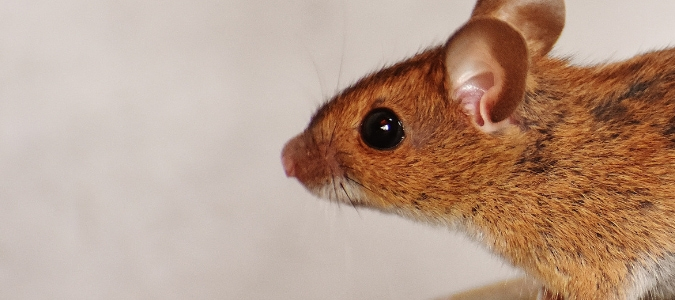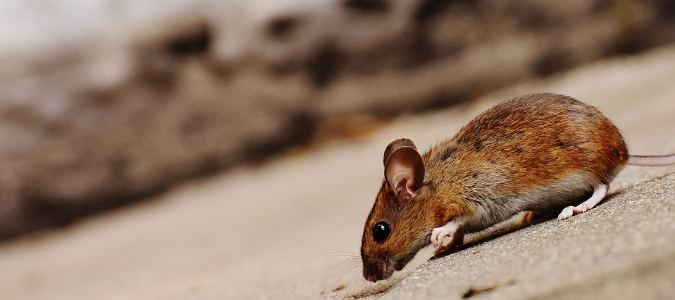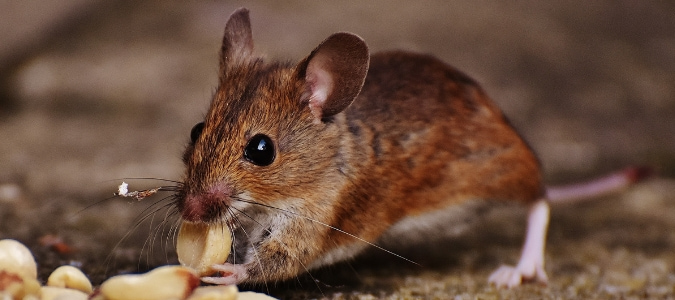
Scritch-scritch-scratch. Scritch-scritch-scratch.
When the sound wakes you up in the middle of the night, you immediately know: something got into the walls.
But what? Rats? Squirrels? Opossums? Raccoons?
Could be any of these uninvited guests. So, you grab a broom and flashlight and head out to search for entry points, not exactly sure what you’re looking for.
Luckily, your mission doesn’t take long. You not only discover the tiny hole the critters used to get in, but also actually see one of the little visitors scampering away—a mouse.
Now comes another important question for any homeowner: was it a house mouse or a deer mouse?
Deer and house mice are two of the most common rodents found in homes in the southern states. A majority of homeowners often have a hard time telling one from the other, so this is one of the most common questions pest professionals are asked.
Why does this matter?
While both types of rodents can cause problems for homeowners when they invade, one definitely causes more problems for homeowners: deer mice.
We say this even though house mice are more common and have been known to cause all kinds of damage and spread sickness and bacteria.
Why is the deer mouse more troublesome? One simple fact: deer mice transmit HPS.
Hantavirus Pulmonary Syndrome is a rare but serious illness that has been reported in various U.S. states, including Texas.
How serious? More than a third of the individuals who contract HPS die.
The most worrisome feature of this disease is that there isn’t a definitive cure. The most effective weapon against HPS, therefore, is prevention.
One aspect of HPS prevention? Controlling the rodents that spread HPS pathogens.
Regardless of which species you’re dealing with, though, harboring mice puts you, your family and your property at risk of untold health, structural and financial risks. Because of that, we wrote this article as a guide to recognizing and dealing with both types of mice.
First step? Know what you’re dealing with.
Identifying The House Mouse
A pointed muzzle, a long hairless (or in some cases, almost hairless) tail and two small rounded ears are the most distinguishing features of the Mus musculus, otherwise known as the house mouse. This variety is the world’s most encountered and economically significant commensal rodent.
What does “commensal” mean? Essentially that the species is closely associated with people and often dependent on us to survive.
An adult house mouse measures three to four inches from the tip of its nose to the base of its tail, but that tail then adds another two to four inches. A mature house mouse typically weighs between 1.4 and 1.6 ounces.
The color of a wild house mouse varies from light to dark brown. The domesticated fancy house mouse, however, may come in many different colors, ranging from black to champagne to white.
The hair on a house mouse is short. There’s little to no hair on the ears and tail of house mice. These creatures typically produce a high-pitched squeak.
House mice can survive in a wide range of environments, living in and around homes, commercial property and in open green spaces, as well as agricultural fields.
One alarming trait of the house mice is the rapid rate of reproduction. A single female is capable of giving birth to half a dozen young ones every three weeks. In fact, a single house mouse female can give birth to as many as 35 babies in a year.
While house mice, by and large, don’t infect people with serious illnesses, in some cases they have been implicated in the transmission of antibiotic-resistant strains of E. coli Salmonella and C. difficile, among several other potentially fatal diseases.
Identifying The Deer Mouse
The Peromyscus maniculatus, or deer mouse, is different from and distantly related to the house mouse.
The eyes of a deer mouse are comparatively larger than those of a house mouse. Unlike the house mouse, the deer mouse has two-tone coloring. The darker colors are found on the back (dorsal side) of the mouse, while the abdomen and limbs are white.
Deer mice are more agile and better runners and jumpers than their house mouse counterparts. This is the basis of their name. Deer mice are usually between five and eight inches long and weigh anywhere between half and ounce and 3.9 ounces.
Deer mice prefer living outdoors and are principally found in rural areas. Though they rarely venture into residential homes, deer mice can be a menace in outbuildings, farm areas, sheds and vacation homes.
Like the house mouse, deer mice reproduce rapidly. This species has a gestation period of three weeks to 27 days, and the female gives birth to a litter of three to five mice babies each time.
Deer mice are carriers of several dangerous human diseases, including the above-mentioned hantavirus, plague, babesiosis, Ehrlichiosis and Lyme disease, among others.
Dangers Of Mice In A Home
Can mice chew through walls? A mouse can be so innocent-looking that people underestimate the risks these critters pose to our family, pets and property. Homeowners who have dealt with an infestation will tell you this: wild mice are a threat to health and property.
This danger is highest when a wild mouse finds its way into your home and nests there, and it only gets worse as the number of mice in your home multiplies.
The specific damage mice can do includes:
- Structural damage to property and damage to your personal belongings, furniture and other household items as a result of incessant gnawing.
- Electrical fires when a mouse gnaws at electrical equipment, electrical wires or both.
- Spread of disease-causing pathogens, including bacteria and viruses.
- Food and surface contamination from mice urine and droppings.
- Mice bites, which can put one of your family members at risk of contracting rat-bite fever.
- Lack of sleep and irritation if these rodents become a nuisance, especially at night when they are scampering within the walls and attic.
Deer Mouse Vs. House Mouse Droppings
If you are eating lunch while reading this article, it may be best to step away from your plate for a bit. Just want to give you fair warning!
When mice droppings contaminate food and surfaces, they may cause various illnesses—some of which can be fatal. Within six months, a pair of mice will have eaten about four pounds of food, produced over 1,800 droppings, excreted about 12 ounces of urine and contaminated more than ten times the amount of food they’ll have consumed.
We warned you! Gross, yes. Stay with us, though because this information matters.
The average size of a dropping is about a quarter of an inch long, and they’re rod-shaped, smooth and have pointed ends. Fresh droppings are soft and dark. Older droppings become hard and dull. These waste products can typically be found scattered rather than piled together. What’s shocking for such a small animal is that each mouse can be responsible for an average of 50 droppings in a single day.
The bottom line? Mice droppings are a significant health concern. People get sick from ingesting the droppings when they get into food or drinks and by inhaling particles of dried droppings that have become airborne. Food contamination from mice saliva and urine has also been known to cause ailments in humans.
What Attracts Mice To Your Home?
Just like humans, mice have an inherent need for food, good shelter and water. Nature provides all these things for mice. However, since our homes are far much better at satisfying these three needs than the wild, mice are often attracted to human households.
What, specifically, attracts these rodents?
Warmth And Comfort
Mice often try to escape harsh outdoor weather by moving in with you. In winter, when the temperature drops, or during the rainy season, mice will try to get into your house, where it’s dry, warm and cozy. Many times, mice build their nests close to water heaters.
Food
Mice are omnivorous, but they are particularly attracted to seeds, grains, fruits and other carbohydrate-rich foods. That being said, they aren’t picky eaters and will feed on almost anything that humans eat, including freshly cooked meals, food debris, leftover scraps, food that’s been thrown away in garbage bags and trash cans and so on.
If your home provides a mouse with unrestricted access to food, it’s very likely that the mouse will soon nest indoors, particularly when other food sources may be scarce.
Clutter
Mice are attracted to the cluttered areas of a home because they create ideal hiding and nesting spots. Such places are usually in attics, garages and storage areas.
Dark Cozy Corners
Dimly lit basements and attics are a magnet for mice. Since these places are dark, mice feel safe from humans and the house pets that might otherwise prey on them.
Open Trash
Trash bins provide food and at times safe breeding grounds for mice.
Easy Access Into Your Home
Entryways for mice include minuscule gaps in exterior walls, tiny spaces on the roof and plumbing pipe (including the toilet). Rodents may also get in through windows and doors that remain open for long periods.
Lack Of Predators
If Tom and Jerry taught us one thing, it’s that cats and mice can’t live together peacefully. Simply put, cats are an excellent means of mice control. Some of the best cat breeds for catching mice include American Shorthairs, Siberians and Maine Coons.
When To Call An Exterminator For Mice
As we’ve already discussed, mice multiply very fast. Procrastination isn’t an option once you realize that these rascally rodents have invaded your home. There are the key signs that tell you that it’s time to call a pest exterminator.
Evidence Of Mice Damage Or Teeth Marks
Mice need to gnaw on things because their teeth grow continuously. Because of this, you might spot evidence of chew marks on furniture, cardboards, wires, shelves and more. You might also see evidence of shredded material from clothes, pillows or blankets that mice can use to make their nests.
A Mouse (Dead Or Alive) In Plain Sight
This probably is the most obvious sign that your home is infested with mice. You may have an even worse problem if you see multiple mice on multiple occasions.
Mice Droppings
Anything that looks like mice droppings should never be taken lightly, especially when those droppings appear near food preparation surfaces. Call in an exterminator immediately to determine whether there’s a mouse problem in your home to try to avoid a full-blown infestation.
Grease Or Dirt Marks
Mice generally follow the same routes as they explore your home. Over time, their trail may manifest in the form of smudges, stains and other dirt marks on the areas they frequent. Check walls, floorboards and furniture for evidence of mouse activity.
Scratching Noises
Though mice prefer to stay out of sight, these animals aren’t very quiet. You may hear then scratching or scampering around the house, particularly at night when they are most active.
ABC Can Resolve Your Mouse Problem
It’s easy for a mice infestation to get out of hand quickly if the proper interventions aren’t made. ABC’s professional exterminators understand how to get rid of rodents (both deer mice and house mice, along with any types of rats) safely and effectively. Additionally, we can show you how the mice are getting into your home and offer practical solutions on how to keep them away from your property going forward.




